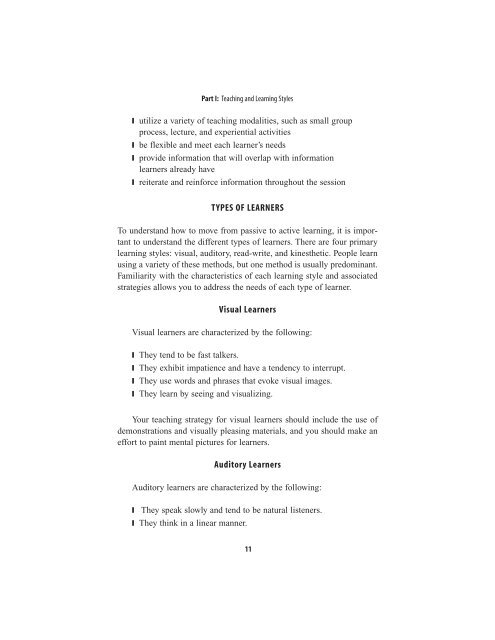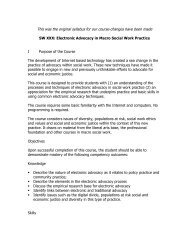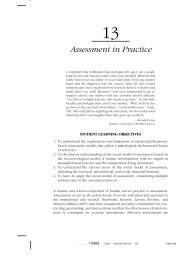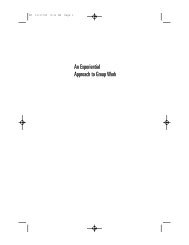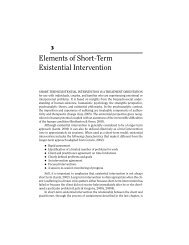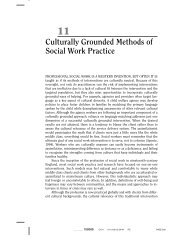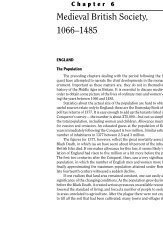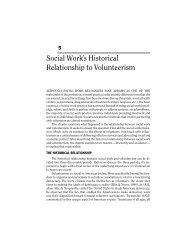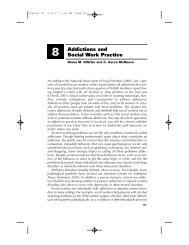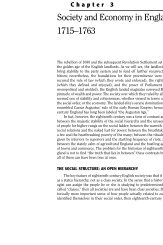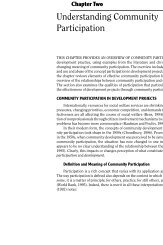TYPES OF LEARNERS Visual Learners Auditory ... - Lyceum Books
TYPES OF LEARNERS Visual Learners Auditory ... - Lyceum Books
TYPES OF LEARNERS Visual Learners Auditory ... - Lyceum Books
You also want an ePaper? Increase the reach of your titles
YUMPU automatically turns print PDFs into web optimized ePapers that Google loves.
Part I: Teaching and Learning Styles❙ utilize a variety of teaching modalities, such as small groupprocess, lecture, and experiential activities❙ be flexible and meet each learner’s needs❙ provide information that will overlap with informationlearners already have❙ reiterate and reinforce information throughout the session<strong>TYPES</strong> <strong>OF</strong> <strong>LEARNERS</strong>To understand how to move from passive to active learning, it is importantto understand the different types of learners. There are four primarylearning styles: visual, auditory, read-write, and kinesthetic. People learnusing a variety of these methods, but one method is usually predominant.Familiarity with the characteristics of each learning style and associatedstrategies allows you to address the needs of each type of learner.<strong>Visual</strong> <strong>Learners</strong><strong>Visual</strong> learners are characterized by the following:❙ They tend to be fast talkers.❙ They exhibit impatience and have a tendency to interrupt.❙ They use words and phrases that evoke visual images.❙ They learn by seeing and visualizing.Your teaching strategy for visual learners should include the use ofdemonstrations and visually pleasing materials, and you should make aneffort to paint mental pictures for learners.<strong>Auditory</strong> <strong>Learners</strong><strong>Auditory</strong> learners are characterized by the following:❙ They speak slowly and tend to be natural listeners.❙ They think in a linear manner.11
Part I: Teaching and Learning Styles❙ They prefer to have things explained to them verbally ratherthan to read written information.❙ They learn by listening and verbalizing.Your teaching strategy for auditory learners should sound good andshould be planned and delivered in the form of an organized conversation.Read-Write <strong>Learners</strong>Read-write learners are characterized by the following:❙ They prefer for information to be displayed in writing, such aslists of ideas.❙ They emphasize text-based input and output.❙ They enjoy reading and writing in all forms.Your teaching strategy for read-write learners should include writingout key words in list form. The learners will learn by silently reading orrewriting their notes repeatedly; writing out in their own words the ideasand principles that were taught or discussed; organizing any diagrams,graphs, other visual depictions into statements (e.g., “The trend is . . . ”);and putting reactions, actions, diagrams, charts, and flowcharts intowords. They like multiple-choice tests.Kinesthetic <strong>Learners</strong>Kinesthetic learners are characterized by the following:❙ They tend to be the slowest talkers of all.❙ They tend to be slow to make decisions.❙ They use all their senses to engage in learning.❙ They learn by doing and solving real-life problems.❙ They like hands-on approaches to things and learn throughtrial and error.12
Part I: Teaching and Learning StylesYour teaching strategy for kinesthetic learners should include handsondemonstrations and case examples to be discussed and solved.Can You Identify Your Predominant Learning Style?There are a variety of types of learners in a single classroom.Therefore, it is important to incorporate multiple teaching methods. It isalso important to know what your own predominant learning style is,because when you teach, you may unintentionally favor your learningstyle and shortchange other types of learners in the classroom.An active learning process involves listening, demonstrating, interacting,and understanding in order to engage all learners. Adult learnerstend to have a need to interact and share with others. Well-designed trainingand educational programs use both active and passive methods. Thereneeds to be some information transfer, but information that is only sharedin a passive learning format is likely to become boring or seem irrelevantto learners. The key to teaching adults is to provide new information thatis relevant and usable within a relatively short period of time. A goodframework to keep in mind is the active training credo:What I hear, I forget.What I hear and see, I remember a little.What I hear, see, and ask questions about or discuss withsomeone else, I begin to understand.What I hear, see, discuss, and do, I acquire knowledge and skill.What I teach to another, I master. (Silberman, 1996, p. 1)As a teacher, your goal is not only to present information that learnersneed but also to facilitate experiences that will help them gain andmaster the knowledge and skills that they need to know and practice. Byusing a variety of teaching techniques and by actively involving learnersin the experience, we increase the chances that they will retain and use theinformation.I always try to take into consideration what I call the Sesame Streetfactor. Most Generation Xers and Millennials grew up on Sesame Street,which uses short vignettes that are usually no longer than one or two13
Part I: Teaching and Learning Stylesminutes. Children who watched Sesame Street are now adults who wanttheir information in short and quick forms. The average adult attention spanis between six and twenty minutes, but this varies greatly depending on factorssuch as the initial interest in the topic, the heat of the room, the time ofday, and the energy level of the learner (Johnstone & Percival, 1976;Middendorf & Kalish, 1996). A change of pace at least every seven to tenminutes can give participants the chance to refocus and renew their interestin the topic (Jones, Peters, & Shields, 2007). Thus it is important that thepace of the teaching correspond to the attention span of the learners.For teachers who are more comfortable with the lecture-only teachingstyle and learners who are more comfortable with passive learning, groupinvolvement and active participation may seem problematic. Instructorsmay feel that they lose control of the class when they allow exercises todominate classroom time. <strong>Learners</strong> may feel they would be learning moreif they could get the information through lecture or readings. As teachers,we must remember that learners are capable of cognitively understandinga great deal of information, but they can only retain segments and willonly experience a value change based on some of that learning experience.We can increase retention and behavior/value change by utilizingmultiple training styles such as lecture, experiential activities, and smalland large group activities, and by repeating the information throughoutthe session.FACTORS AFFECTING LEARNINGLearning is not an automatic process. There are a number of factors thatcan inhibit the process. These may include one or more of the following:❙ Learner feels he or she is at least as competent in the subjectmatter as the instructor.❙ Learner resents authority figures such as the instructor.❙ Learner is fearful of being seen as inferior or of beingembarrassed.❙ Learner is anxious.❙ Learner has had a bad learning experience in the past.14
Part I: Teaching and Learning Styles❙ Learner comes to the session with other problems on his orher mind and is unable to focus.❙ Learner is in class against his or her will and resents this.❙ Learner is interested in the material but is constrained by timeand focused on other priorities.❙ Learner has personal barriers or biases to learning about thetopic. For example, a learner may be resistant to learningabout a topic (e.g., evolution) that contradicts his or herreligious beliefs.❙ Learner has culturally based inhibitions to discussing orlearning about the topic.❙ Learner focuses on an annoying mannerism of the instructor.❙ Learner is uncomfortable with the learning technique beingused; this is common when learners are being introduced totechnology for the first time.Although it is difficult to address everyone’s needs, it is important tomeet as many needs as possible. To accomplish this, the instructor shouldassess learners’ needs and issues. One way to do this is to simply ask thelearners what their expectations are for the class session. There are moresophisticated assessment tools as well. Any of the ten methods describedin part II can be used as a formative evaluation measure to make sure thata topic was understood before the class moves forward to the next topic.I prefer to use continuous evaluation mechanisms throughout the learningsession to provide opportunities for learners to reflect on the content thatwas covered and answer questions while they are fresh in the learners’minds. Sometimes learners have questions about issues that are beyondthe scope of the instructor’s responsibilities. The value of the questionshould be acknowledged, but you should politely tell the learner that thequestion is beyond the purview of the course. However, you may still beable to establish the value and relevance of the questions to the entirecourse.15


